對話方塊概觀
獨立應用程式通常具有主視窗,其中顯示應用程式操作的主要資訊,並透過功能表列、工具列和狀態列等使用者介面 (UI) 機制公開處理該資料的功能。 重要的應用程式還可能顯示其他視窗來執行下列動作:
對使用者顯示特定資訊。
向使用者收集資訊。
顯示並收集資訊。
這種視窗稱為「對話方塊」,可分為兩種類型︰強制回應和非強制回應。
當某個函式需要使用者提供其他資料才能繼續時,該函式會顯示「強制回應」對話方塊。 由於該函式需要透過強制回應對話方塊收集資料,因此當強制回應對話方塊保持開啟時,也可以防止使用者在應用程式中啟動其他視窗。 在大多數情況下,強制回應對話方塊可讓使用者藉由按下 [確定] 或 [取消] 按鈕,指出完成強制回應對話方塊。 按下 [確定] 按鈕表示使用者已輸入資料,並且希望此函式繼續處理該資料。 按下 [取消] 按鈕表示使用者想要完全停止執行此函式。 強制回應對話方塊的最常見範例為開啟、儲存及列印資料。
另一方面,「非強制回應」對話方塊在開啟時,不會防止使用者啟動其他視窗。 例如,如果使用者想要尋找出現在文件中的特定字組,主視窗通常會開啟對話方塊,詢問使用者要尋找哪個字組。 不過,由於尋找字組並不會防止使用者編輯文件,因此對話方塊不需要是強制回應。 非強制回應對話方塊至少會提供 [關閉] 按鈕以關閉對話方塊,並可能會提供其他按鈕以執行特定函式,例如 [尋找下一個] 按鈕以尋找下一個符合字組搜尋準則的字組。
Windows Presentation Foundation (WPF) 可讓您建立多種對話方塊類型,包括訊息方塊、通用對話方塊和自訂對話方塊。 本主題將討論每種類型,而 Dialog Box Sample (對話方塊範例) 將提供相符的範例。
訊息方塊
「訊息方塊」是可用來顯示文字資訊,並讓使用者透過按鈕做出決定的對話方塊。 下圖所示的訊息方塊顯示文字資訊、提出問題,並提供使用者三個按鈕來回答問題。
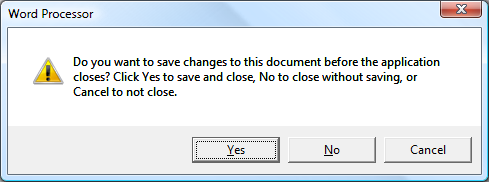 [文字處理器] 對話方塊,詢問您是否要在應用程式關閉之前儲存變更。
[文字處理器] 對話方塊,詢問您是否要在應用程式關閉之前儲存變更。
若要建立訊息方塊,您可以使用 MessageBox 類別。 MessageBox 可讓您使用如下所示的程式碼,設定訊息方塊文字、標題、圖示和按鈕。
// Configure the message box to be displayed
string messageBoxText = "Do you want to save changes?";
string caption = "Word Processor";
MessageBoxButton button = MessageBoxButton.YesNoCancel;
MessageBoxImage icon = MessageBoxImage.Warning;
' Configure the message box to be displayed
Dim messageBoxText As String = "Do you want to save changes?"
Dim caption As String = "Word Processor"
Dim button As MessageBoxButton = MessageBoxButton.YesNoCancel
Dim icon As MessageBoxImage = MessageBoxImage.Warning
若要顯示訊息方塊,您可以呼叫 staticShow 方法,如下列程式碼所示。
// Display message box
MessageBox.Show(messageBoxText, caption, button, icon);
' Display message box
MessageBox.Show(messageBoxText, caption, button, icon)
當顯示訊息方塊的程式碼必須偵測及處理使用者的決定時 (按下哪個按鈕),程式碼可以查看訊息方塊結果,如下列程式碼所示。
// Display message box
MessageBoxResult result = MessageBox.Show(messageBoxText, caption, button, icon);
// Process message box results
switch (result)
{
case MessageBoxResult.Yes:
// User pressed Yes button
// ...
break;
case MessageBoxResult.No:
// User pressed No button
// ...
break;
case MessageBoxResult.Cancel:
// User pressed Cancel button
// ...
break;
}
' Display message box
Dim result As MessageBoxResult = MessageBox.Show(messageBoxText, caption, button, icon)
' Process message box results
Select Case result
Case MessageBoxResult.Yes
' User pressed Yes button
' ...
Case MessageBoxResult.No
' User pressed No button
' ...
Case MessageBoxResult.Cancel
' User pressed Cancel button
' ...
End Select
如需使用訊息方塊的詳細資訊,請參閱 MessageBox、MessageBox Sample (MessageBox 範例) 和 DialogBox Sample (對話方塊範例)。
雖然 MessageBox 所提供的對話方塊使用者體驗可能非常簡潔,但使用 MessageBox 的優點在於,這是在部分信任安全性沙箱內執行的應用程式 (請見安全性) 唯一能顯示的視窗類型,例如 XAML 瀏覽器應用程式 (XBAP)。
大多數對話方塊所顯示及收集的資料會比訊息方塊的結果更複雜,包括文字、選取範圍 (核取方塊)、互斥選取範圍 (選項按鈕),以及清單選取範圍 (清單方塊、下拉式方塊、下拉式清單方塊)。 為此,Windows Presentation Foundation (WPF) 提供幾種通用對話方塊,並允許您建立自己的對話方塊,不過只有以完全信任執行的應用程式才能使用任一對話方塊。
通用對話方塊
Windows 使用所有應用程式通用之各種可重複使用的對話方塊,包括用於開啟檔案、儲存檔案和列印的對話方塊。 由於這些對話方塊是由作業系統實作,因此可在作業系統上執行的所有應用程式之間共用,以協助確保使用者體驗的一致性;當使用者在一個應用程式中熟悉如何使用某個作業系統提供的對話方塊時,就不需要了解如何在其他應用程式中使用該對話方塊。 因為這些對話方塊可供所有應用程式使用,並協助提供一致的使用者體驗,所以稱為「通用對話方塊」。
Windows Presentation Foundation (WPF) 會封裝 [開啟檔案]、[儲存檔案] 和 [列印] 通用對話方塊,然後將這些對話方塊公開為受控類別,以供您在獨立應用程式中使用。 本主題提供每個對話方塊的簡短概觀。
[開啟檔案] 對話方塊
如下圖所示,檔案開啟功能使用 [開啟檔案] 對話方塊,來擷取要開啟之檔案的名稱。
 [開啟] 對話方塊,顯示要擷取檔案的位置。
[開啟] 對話方塊,顯示要擷取檔案的位置。
通用 [開啟檔案] 對話方塊會實作為 OpenFileDialog 類別,且位於 Microsoft.Win32 命名空間中。 下列程式碼示範如何建立、設定及顯示一個對話方塊,以及如何處理結果。
// Configure open file dialog box
Microsoft.Win32.OpenFileDialog dlg = new Microsoft.Win32.OpenFileDialog();
dlg.FileName = "Document"; // Default file name
dlg.DefaultExt = ".txt"; // Default file extension
dlg.Filter = "Text documents (.txt)|*.txt"; // Filter files by extension
// Show open file dialog box
Nullable<bool> result = dlg.ShowDialog();
// Process open file dialog box results
if (result == true)
{
// Open document
string filename = dlg.FileName;
}
' Configure open file dialog box
Dim dlg As New Microsoft.Win32.OpenFileDialog()
dlg.FileName = "Document" ' Default file name
dlg.DefaultExt = ".txt" ' Default file extension
dlg.Filter = "Text documents (.txt)|*.txt" ' Filter files by extension
' Show open file dialog box
Dim result? As Boolean = dlg.ShowDialog()
' Process open file dialog box results
If result = True Then
' Open document
Dim filename As String = dlg.FileName
End If
如需 [開啟檔案] 對話方塊的詳細資訊,請參閱 Microsoft.Win32.OpenFileDialog。
注意
以部分信任執行的應用程式可以使用 OpenFileDialog 安全地擷取檔案名稱 (請參閱安全性)。
儲存對話方塊
如下圖所示,檔案儲存功能使用 [儲存檔案] 對話方塊,來擷取要儲存之檔案的名稱。
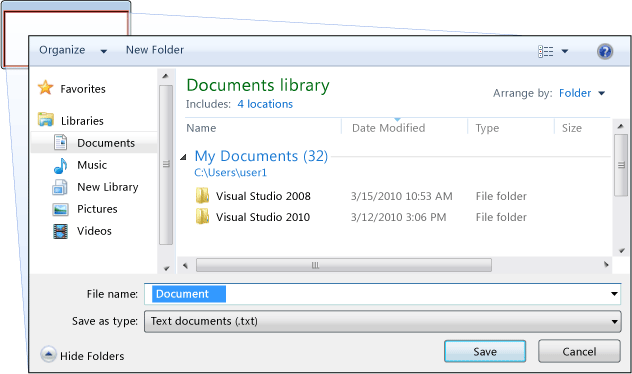 [另存新檔] 對話方塊,顯示儲存檔案的位置。
[另存新檔] 對話方塊,顯示儲存檔案的位置。
通用 [儲存檔案] 對話方塊會實作為 SaveFileDialog 類別,且位於 Microsoft.Win32 命名空間中。 下列程式碼示範如何建立、設定及顯示一個對話方塊,以及如何處理結果。
// Configure save file dialog box
Microsoft.Win32.SaveFileDialog dlg = new Microsoft.Win32.SaveFileDialog();
dlg.FileName = "Document"; // Default file name
dlg.DefaultExt = ".txt"; // Default file extension
dlg.Filter = "Text documents (.txt)|*.txt"; // Filter files by extension
// Show save file dialog box
Nullable<bool> result = dlg.ShowDialog();
// Process save file dialog box results
if (result == true)
{
// Save document
string filename = dlg.FileName;
}
' Configure save file dialog box
Dim dlg As New Microsoft.Win32.SaveFileDialog()
dlg.FileName = "Document" ' Default file name
dlg.DefaultExt = ".txt" ' Default file extension
dlg.Filter = "Text documents (.txt)|*.txt" ' Filter files by extension
' Show save file dialog box
Dim result? As Boolean = dlg.ShowDialog()
' Process save file dialog box results
If result = True Then
' Save document
Dim filename As String = dlg.FileName
End If
如需 [儲存檔案] 對話方塊的詳細資訊,請參閱 Microsoft.Win32.SaveFileDialog。
列印對話方塊
如下圖所示,列印功能使用 [列印] 對話方塊,來選擇及設定使用者想要列印資料的目標印表機。
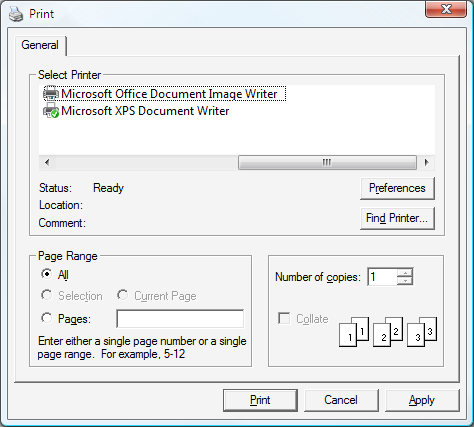 顯示 [列印] 對話方塊的螢幕截圖。
顯示 [列印] 對話方塊的螢幕截圖。
通用 [列印] 對話方塊會實作為 PrintDialog 類別,且位於 System.Windows.Controls 命名空間中。 下列程式碼示範如何建立、設定及顯示一個對話方塊。
// Configure printer dialog box
System.Windows.Controls.PrintDialog dlg = new System.Windows.Controls.PrintDialog();
dlg.PageRangeSelection = PageRangeSelection.AllPages;
dlg.UserPageRangeEnabled = true;
// Show save file dialog box
Nullable<bool> result = dlg.ShowDialog();
// Process save file dialog box results
if (result == true)
{
// Print document
}
' Configure printer dialog box
Dim dlg As New PrintDialog()
dlg.PageRangeSelection = PageRangeSelection.AllPages
dlg.UserPageRangeEnabled = True
' Show save file dialog box
Dim result? As Boolean = dlg.ShowDialog()
' Process save file dialog box results
If result = True Then
' Print document
End If
如需 [列印] 對話方塊的詳細資訊,請參閱 System.Windows.Controls.PrintDialog。 如需在 WPF 中列印的詳細討論,請參閱列印概觀。
自訂對話方塊
雖然通用對話方塊很有用,而且應該盡可能使用,但這類對話方塊並不支援定義域專屬對話方塊的需求。 在此情況下,您必須建立自己的對話方塊。 如稍後所示,對話方塊是具有特殊行為的視窗。 Window 實作這些行為,因此您會使用 Window 來建立自訂強制回應和非強制回應對話方塊。
建立自訂強制回應對話方塊
本主題以 [Window] 對話方塊為例,說明如何使用 Margins 來建立一般強制回應對話方塊方塊實作 (請參閱 Dialog Box Sample (對話方塊範例))。 [Margins] 對話方塊如下圖所示。
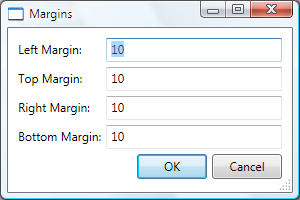 [邊界] 對話方塊,其中包含定義左邊界、上邊界、右邊界和下邊界的欄位。
[邊界] 對話方塊,其中包含定義左邊界、上邊界、右邊界和下邊界的欄位。
設定強制回應對話方塊
一般對話方塊的使用者介面包括:
收集想要的資料所需的各種控制項。
顯示 [確定] 按鈕,使用者可按一下來關閉對話方塊、返回函式,並繼續處理。
顯示 [取消] 按鈕,使用者可按一下來關閉對話方塊,並停止函式進一步處理。
在標題列中顯示 [關閉] 按鈕。
圖示。
[最小化]、[最大化] 和 [還原] 按鈕。
顯示 [系統] 功能表以最小化、最大化、還原及關閉對話方塊。
在開啟對話方塊的視窗上方和中央開啟。
能夠盡可能調整大小,以防止對話方塊太小,併為使用者提供有用的預設大小。 這需要您同時設定預設值和最小長寬。
按下 ESC 鍵應該設定為相當於按下 [取消] 按鈕的鍵盤快速鍵。 您可以將 [取消] 按鈕的 IsCancel 屬性設定為 [
true]。ENTER (或 RETURN) 鍵應設定為相當於按下 [確定] 按鈕的鍵盤快速鍵。 您可以透過調整 [確定]按鈕
true的 IsDefault 屬性進行設定。
下列程式碼示範這項設定。
<Window
xmlns="http://schemas.microsoft.com/winfx/2006/xaml/presentation"
xmlns:x="http://schemas.microsoft.com/winfx/2006/xaml"
x:Class="SDKSample.MarginsDialogBox"
xmlns:local="clr-namespace:SDKSample"
Title="Margins"
Height="190"
Width="300"
MinHeight="10"
MinWidth="300"
ResizeMode="CanResizeWithGrip"
ShowInTaskbar="False"
WindowStartupLocation="CenterOwner"
FocusManager.FocusedElement="{Binding ElementName=leftMarginTextBox}">
<Grid>
<!-- Accept or Cancel -->
<StackPanel Grid.Column="0" Grid.ColumnSpan="2" Grid.Row="4">
<Button Name="okButton" Click="okButton_Click" IsDefault="True">OK</Button>
<Button Name="cancelButton" IsCancel="True">Cancel</Button>
</StackPanel>
</Grid >
</Window>
using System.Windows;
using System.Windows.Controls;
using System.Windows.Input;
namespace SDKSample
{
public partial class MarginsDialogBox : Window
{
public MarginsDialogBox()
{
InitializeComponent();
}
}
}
Imports System.Windows
Imports System.Windows.Controls
Imports System.Windows.Input
Namespace SDKSample
Public Class MarginsDialogBox
Inherits Window
Public Sub New()
Me.InitializeComponent()
End Sub
End Class
End Namespace
對話方塊的使用者體驗也會延伸至開啟對話方塊之視窗的功能表列。 當功能表項目所執行的函式需要透過對話方塊進行使用者互動才能繼續時,該函式的功能表項目會在其標頭中顯示省略符號,如下所示。
<!--Main Window-->
<MenuItem Name="formatMarginsMenuItem" Header="_Margins..." Click="formatMarginsMenuItem_Click" />
當功能表項目所執行的函式顯示不需要使用者互動的對話方塊時 (例如 [關於] 對話方塊),則不需要省略符號。
開啟強制回應對話方塊
對話方塊通常是使用者選取功能表項目以執行定義域專屬函式所顯示的結果,例如在文書處理器中設定文件的邊界。 將視窗顯示為對話方塊類似於顯示標準視窗,不過需要進行額外的對話方塊專屬設定。 具現化、設定及開啟對話方塊的整個過程如下列程式碼所示。
using System;
using System.ComponentModel;
using System.Windows;
using System.Windows.Controls;
using Microsoft.Win32;
namespace SDKSample
{
public partial class MainWindow : Window
{
bool needsToBeSaved;
void formatMarginsMenuItem_Click(object sender, RoutedEventArgs e)
{
// Instantiate the dialog box
MarginsDialogBox dlg = new MarginsDialogBox();
// Configure the dialog box
dlg.Owner = this;
dlg.DocumentMargin = this.documentTextBox.Margin;
// Open the dialog box modally
dlg.ShowDialog();
}
}
}
Imports System.ComponentModel
Imports System.Windows
Imports System.Windows.Controls
Imports Microsoft.Win32
Namespace SDKSample
Public Class MainWindow
Inherits Window
Private Sub formatMarginsMenuItem_Click(ByVal sender As Object, ByVal e As RoutedEventArgs)
' Instantiate the dialog box
Dim dlg As New MarginsDialogBox
' Configure the dialog box
dlg.Owner = Me
dlg.DocumentMargin = Me.documentTextBox.Margin
' Open the dialog box modally
dlg.ShowDialog()
End Sub
End Class
End Namespace
這裡的程式碼會將預設資訊 (目前邊界) 傳遞給對話方塊。 它也會使用顯示對話方塊之視窗的參考值來設定 Window.Owner 屬性。 一般而言,您一律必須設定對話方塊的主控視窗,以提供所有對話方塊通用的視窗狀態相關行為 (如需詳細資訊,請參閱 WPF 視窗概觀)。
注意
您必須提供主控視窗,才能支援使用者介面 (UI) 自動化 (請參閱使用者介面自動化概觀)。
設定對話方塊之後,藉由呼叫 ShowDialog 方法即可強制顯示對話方塊。
驗證使用者提供的資料
在開啟對話方塊且使用者提供所需資料之後,對話方塊會基於下列原因負責確保提供的資料有效:
從安全性的觀點來看,應該驗證所有輸入。
從定義域專屬的觀點來看,資料驗證可以防止程式碼處理錯誤的資料,這可能會擲回例外狀況。
從使用者體驗的觀點來看,對話方塊可藉由對使用者顯示哪些輸入的資料無效來協助使用者。
從效能的觀點來看,多層式應用程式中的資料驗證可以減少用戶層與應用程式層之間的來回行程次數,特別是當應用程式是由 Web 服務或伺服器架構資料庫組成時。
為了驗證 WPF 中的繫結控制項,您必須定義驗證規則,並建立此規則與繫結的關聯。 驗證規則是衍生自 ValidationRule 的自定義類別。 下列範例顯示驗證規則 MarginValidationRule,該規則會確認繫結值為 Double 並位於指定的範圍內。
using System.Globalization;
using System.Windows.Controls;
namespace SDKSample
{
public class MarginValidationRule : ValidationRule
{
double minMargin;
double maxMargin;
public double MinMargin
{
get { return this.minMargin; }
set { this.minMargin = value; }
}
public double MaxMargin
{
get { return this.maxMargin; }
set { this.maxMargin = value; }
}
public override ValidationResult Validate(object value, CultureInfo cultureInfo)
{
double margin;
// Is a number?
if (!double.TryParse((string)value, out margin))
{
return new ValidationResult(false, "Not a number.");
}
// Is in range?
if ((margin < this.minMargin) || (margin > this.maxMargin))
{
string msg = string.Format("Margin must be between {0} and {1}.", this.minMargin, this.maxMargin);
return new ValidationResult(false, msg);
}
// Number is valid
return new ValidationResult(true, null);
}
}
}
Imports System.Globalization
Imports System.Windows.Controls
Namespace SDKSample
Public Class MarginValidationRule
Inherits ValidationRule
Private _maxMargin As Double
Private _minMargin As Double
Public Property MaxMargin() As Double
Get
Return Me._maxMargin
End Get
Set(ByVal value As Double)
Me._maxMargin = value
End Set
End Property
Public Property MinMargin() As Double
Get
Return Me._minMargin
End Get
Set(ByVal value As Double)
Me._minMargin = value
End Set
End Property
Public Overrides Function Validate(ByVal value As Object, ByVal cultureInfo As CultureInfo) As ValidationResult
Dim margin As Double
' Is a number?
If Not Double.TryParse(CStr(value), margin) Then
Return New ValidationResult(False, "Not a number.")
End If
' Is in range?
If ((margin < Me.MinMargin) OrElse (margin > Me.MaxMargin)) Then
Dim msg As String = String.Format("Margin must be between {0} and {1}.", Me.MinMargin, Me.MaxMargin)
Return New ValidationResult(False, msg)
End If
' Number is valid
Return New ValidationResult(True, Nothing)
End Function
End Class
End Namespace
在這段程式碼中,驗證規則的驗證邏輯是藉由覆寫 Validate 方法來實作,該方法會驗證資料並傳回適當的 ValidationResult。
若要建立驗證規則與繫結控制項的關聯,您可以使用下列標記。
<Window
xmlns="http://schemas.microsoft.com/winfx/2006/xaml/presentation"
xmlns:x="http://schemas.microsoft.com/winfx/2006/xaml"
x:Class="SDKSample.MarginsDialogBox"
xmlns:local="clr-namespace:SDKSample"
Title="Margins"
Height="190"
Width="300"
MinHeight="10"
MinWidth="300"
ResizeMode="CanResizeWithGrip"
ShowInTaskbar="False"
WindowStartupLocation="CenterOwner"
FocusManager.FocusedElement="{Binding ElementName=leftMarginTextBox}">
<Grid>
<!-- Left Margin -->
<Label Grid.Column="0" Grid.Row="0">Left Margin:</Label>
<TextBox Name="leftMarginTextBox" Grid.Column="1" Grid.Row="0">
<TextBox.Text>
<Binding Path="Left" UpdateSourceTrigger="PropertyChanged">
<Binding.ValidationRules>
<local:MarginValidationRule MinMargin="0" MaxMargin="10" />
</Binding.ValidationRules>
</Binding>
</TextBox.Text>
</TextBox>
</Grid >
</Window>
建立驗證規則的關聯之後,WPF 會在輸入資料到繫結控制項時,自動套用此規則。 當控制項包含無效的資料時,WPF 會在無效的控制項周圍顯示紅色框線,如下圖所示。
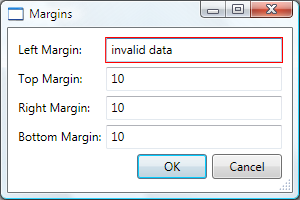 [邊界] 對話方塊,在無效左邊界值周圍加上紅色框線。
[邊界] 對話方塊,在無效左邊界值周圍加上紅色框線。
在使用者輸入有效的資料之前,WPF 不會將使用者侷限在無效的控制項。 這是很好的對話方塊行為;使用者應該能夠自由地巡覽對話方塊中的控制項,而不論資料是否有效。 不過,這表示使用者可以輸入無效的資料並按下 [確定] 按鈕。 因此,當處理 Click 事件而按下 [確定] 按鈕時,您的程式碼也需要驗證對話方塊中的所有控制項。
using System.Windows;
using System.Windows.Controls;
using System.Windows.Input;
namespace SDKSample
{
public partial class MarginsDialogBox : Window
{
void okButton_Click(object sender, RoutedEventArgs e)
{
// Don't accept the dialog box if there is invalid data
if (!IsValid(this)) return;
}
// Validate all dependency objects in a window
bool IsValid(DependencyObject node)
{
// Check if dependency object was passed
if (node != null)
{
// Check if dependency object is valid.
// NOTE: Validation.GetHasError works for controls that have validation rules attached
bool isValid = !Validation.GetHasError(node);
if (!isValid)
{
// If the dependency object is invalid, and it can receive the focus,
// set the focus
if (node is IInputElement) Keyboard.Focus((IInputElement)node);
return false;
}
}
// If this dependency object is valid, check all child dependency objects
foreach (object subnode in LogicalTreeHelper.GetChildren(node))
{
if (subnode is DependencyObject)
{
// If a child dependency object is invalid, return false immediately,
// otherwise keep checking
if (IsValid((DependencyObject)subnode) == false) return false;
}
}
// All dependency objects are valid
return true;
}
}
}
Imports System.Windows
Imports System.Windows.Controls
Imports System.Windows.Input
Namespace SDKSample
Public Class MarginsDialogBox
Inherits Window
Private Sub okButton_Click(ByVal sender As Object, ByVal e As RoutedEventArgs)
' Don't accept the dialog box if there is invalid data
If Not Me.IsValid(Me) Then Return
End Sub
' Validate all dependency objects in a window
Private Function IsValid(ByVal node As DependencyObject) As Boolean
' Check if dependency object was passed and if dependency object is valid.
' NOTE: Validation.GetHasError works for controls that have validation rules attached
If ((Not node Is Nothing) AndAlso Validation.GetHasError(node)) Then
' If the dependency object is invalid, and it can receive the focus,
' set the focus
If TypeOf node Is IInputElement Then
Keyboard.Focus(DirectCast(node, IInputElement))
End If
Return False
End If
' If this dependency object is valid, check all child dependency objects
Dim subnode As Object
For Each subnode In LogicalTreeHelper.GetChildren(node)
If (TypeOf subnode Is DependencyObject AndAlso Not Me.IsValid(DirectCast(subnode, DependencyObject))) Then
' If a child dependency object is invalid, return false immediately,
' otherwise keep checking
Return False
End If
Next
' All dependency objects are valid
Return True
End Function
End Class
End Namespace
這段程式碼會列舉視窗上的所有相依性物件,而且如果所有物件都無效 (如 GetHasError 所傳回),無效的控制項會取得焦點、IsValid 方法會傳回 false,且視窗會視為無效。
一旦對話方塊有效,就可以安全地將它關閉並傳回。 在傳回過程中,必須將結果傳回呼叫函式。
設定強制回應對話方塊結果
使用 ShowDialog 開啟對話方塊基本上就與呼叫方法相同:使用 ShowDialog 開啟對話方塊的程式碼會等到 ShowDialog 回傳為止。 當 ShowDialog 傳回時,呼叫回傳的程式碼必須根據使用者按下的是 [確定] 按鈕或 [取消] 按鈕,決定要繼續處理,還是停止處理。 為了加速這項決定,對話方塊必須以 ShowDialog 方法所傳回的 Boolean 值,傳回使用者的選擇。
按下 [確定] 按鈕時,ShowDialog 應回傳 true。 這可藉由設定按下 [確定] 按鈕時之對話方塊的 DialogResult 屬性來達成。
using System.Windows;
using System.Windows.Controls;
using System.Windows.Input;
namespace SDKSample
{
public partial class MarginsDialogBox : Window
{
void okButton_Click(object sender, RoutedEventArgs e)
{
this.DialogResult = true;
}
}
}
Imports System.Windows
Imports System.Windows.Controls
Imports System.Windows.Input
Namespace SDKSample
Public Class MarginsDialogBox
Inherits Window
Private Sub okButton_Click(ByVal sender As Object, ByVal e As RoutedEventArgs)
' Dialog box accepted
MyBase.DialogResult = New Nullable(Of Boolean)(True)
End Sub
End Class
End Namespace
請注意,設定 DialogResult 屬性也會導致窗口自動關閉,減少明確呼叫 Close 的需求。
按下 [取消] 按鈕時,ShowDialog 應該傳回 false,同時需要設定 DialogResult 屬性。
using System.Windows;
using System.Windows.Controls;
using System.Windows.Input;
namespace SDKSample
{
public partial class MarginsDialogBox : Window
{
void cancelButton_Click(object sender, RoutedEventArgs e)
{
// Dialog box canceled
this.DialogResult = false;
}
}
}
Imports System.Windows
Imports System.Windows.Controls
Imports System.Windows.Input
Namespace SDKSample
Public Class MarginsDialogBox
Inherits Window
Private Sub cancelButton_Click(ByVal sender As Object, ByVal e As RoutedEventArgs)
' Dialog box canceled
Me.DialogResult = False
End Sub
End Class
End Namespace
當按鈕的 IsCancel 屬性設定為 true,且使用者按下 [取消] 按鈕或 ESC 鍵時, DialogResult 會自動設定為 false。 下列標記與上述程式碼有同樣的效果,但不需要處理 Click 事件。
<Button Name="cancelButton" IsCancel="True">Cancel</Button>
當使用者按下標題列中的 [關閉] 按鈕,或從 [系統] 功能表選擇 [關閉] 功能表項目時,對話方塊會自動傳回 false。
處理從強制回應對話方塊傳回的資料
當對話方塊設定 DialogResult 時,開啟它的函式可以在傳回 ShowDialog 時檢查 DialogResult 屬性,以取得對話方塊結果。
using System;
using System.ComponentModel;
using System.Windows;
using System.Windows.Controls;
using Microsoft.Win32;
namespace SDKSample
{
public partial class MainWindow : Window
{
void formatMarginsMenuItem_Click(object sender, RoutedEventArgs e)
{
// Process data entered by user if dialog box is accepted
if (dlg.DialogResult == true)
{
// Update fonts
this.documentTextBox.Margin = dlg.DocumentMargin;
}
}
}
}
Imports System.ComponentModel
Imports System.Windows
Imports System.Windows.Controls
Imports Microsoft.Win32
Namespace SDKSample
Public Class MainWindow
Inherits Window
Private Sub formatMarginsMenuItem_Click(ByVal sender As Object, ByVal e As RoutedEventArgs)
' Process data entered by user if dialog box is accepted
If (dlg.DialogResult.GetValueOrDefault = True) Then
Me.documentTextBox.Margin = dlg.DocumentMargin
End If
End Sub
End Class
End Namespace
如果對話方塊結果為 true,此函式會使用該值作為提示,以擷取及處理使用者提供的資料。
注意
傳回 ShowDialog 之後,對話方塊便無法重新開啟。 您必須改為建立新的執行個體。
如果對話方塊結果為 false,此函式應該適當地結束處理。
建立自訂非強制回應對話方塊
非強制回應對話方塊 (例如下圖所示的 [尋找] 對話方塊) 與強制回應對話方塊具有相同的基本外觀。
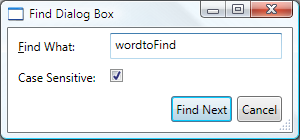 顯示 [尋找] 對話方塊的螢幕截圖。
顯示 [尋找] 對話方塊的螢幕截圖。
不過,其行為稍有不同,如下列各節中所述。
開啟非強制回應對話方塊
呼叫 Show 方法會開啟非強制回應對話方塊。
<!--Main Window-->
<MenuItem Name="editFindMenuItem" Header="_Find" InputGestureText="Ctrl+F" Click="editFindMenuItem_Click" />
using System;
using System.ComponentModel;
using System.Windows;
using System.Windows.Controls;
using Microsoft.Win32;
namespace SDKSample
{
public partial class MainWindow : Window
{
void editFindMenuItem_Click(object sender, RoutedEventArgs e)
{
// Instantiate the dialog box
FindDialogBox dlg = new FindDialogBox(this.documentTextBox);
// Configure the dialog box
dlg.Owner = this;
dlg.TextFound += new TextFoundEventHandler(dlg_TextFound);
// Open the dialog box modally
dlg.Show();
}
}
}
Imports System.ComponentModel
Imports System.Windows
Imports System.Windows.Controls
Imports Microsoft.Win32
Namespace SDKSample
Public Class MainWindow
Inherits Window
Private Sub editFindMenuItem_Click(ByVal sender As Object, ByVal e As RoutedEventArgs)
Dim dlg As New FindDialogBox(Me.documentTextBox)
dlg.Owner = Me
AddHandler dlg.TextFound, New TextFoundEventHandler(AddressOf Me.dlg_TextFound)
dlg.Show()
End Sub
End Class
End Namespace
與 ShowDialog 不同,Show 會立即傳回。 因此,呼叫視窗無法得知非強制回應對話方塊何時關閉,因此不會知道何時要檢查對話方塊結果,或從對話方塊取得資料以進一步處理。 相反地,對話方塊必須建立其他方式,以將資料傳回呼叫視窗進行處理。
處理非強制回應對話方塊傳回的資料
在此範例中,FindDialogBox 可能會根據搜尋的文字,不定期地將一或多個找到的結果傳回主視窗。 如同強制回應對話方塊,非強制回應對話方塊可以透過屬性傳回結果。 不過,主控對話方塊的視窗必須知道何時要查看這些屬性。 其中一個做法是,讓對話方塊實作每次找到文字時所引發的事件。 FindDialogBox 會基於此目的實作 TextFoundEvent,因此首先需要委派。
using System;
namespace SDKSample
{
public delegate void TextFoundEventHandler(object sender, EventArgs e);
}
Namespace SDKSample
Public Delegate Sub TextFoundEventHandler(ByVal sender As Object, ByVal e As EventArgs)
End Namespace
FindDialogBox 使用 TextFoundEventHandler 委派來實作 TextFoundEvent。
using System;
using System.Windows;
using System.Windows.Controls;
using System.Text.RegularExpressions;
namespace SDKSample
{
public partial class FindDialogBox : Window
{
public event TextFoundEventHandler TextFound;
protected virtual void OnTextFound()
{
TextFoundEventHandler textFound = this.TextFound;
if (textFound != null) textFound(this, EventArgs.Empty);
}
}
}
Imports System.Windows
Imports System.Windows.Controls
Imports System.Text.RegularExpressions
Namespace SDKSample
Public Class FindDialogBox
Inherits Window
Public Event TextFound As TextFoundEventHandler
Protected Overridable Sub OnTextFound()
RaiseEvent TextFound(Me, EventArgs.Empty)
End Sub
End Class
End Namespace
因此,Find 可在找到搜尋結果時引發事件。
using System;
using System.Windows;
using System.Windows.Controls;
using System.Text.RegularExpressions;
namespace SDKSample
{
public partial class FindDialogBox : Window
{
void findNextButton_Click(object sender, RoutedEventArgs e)
{
// Text found
this.index = match.Index;
this.length = match.Length;
OnTextFound();
}
}
}
Imports System.Windows
Imports System.Windows.Controls
Imports System.Text.RegularExpressions
Namespace SDKSample
Public Class FindDialogBox
Inherits Window
Me.Index = match.Index
Me.Length = match.Length
RaiseEvent TextFound(Me, EventArgs.Empty)
End Class
End Namespace
主控視窗接著需要註冊及處理此事件。
using System;
using System.ComponentModel;
using System.Windows;
using System.Windows.Controls;
using Microsoft.Win32;
namespace SDKSample
{
public partial class MainWindow : Window
{
void dlg_TextFound(object sender, EventArgs e)
{
// Get the find dialog box that raised the event
FindDialogBox dlg = (FindDialogBox)sender;
// Get find results and select found text
this.documentTextBox.Select(dlg.Index, dlg.Length);
this.documentTextBox.Focus();
}
}
}
Imports System.ComponentModel
Imports System.Windows
Imports System.Windows.Controls
Imports Microsoft.Win32
Namespace SDKSample
Public Class MainWindow
Inherits Window
Private Sub dlg_TextFound(ByVal sender As Object, ByVal e As EventArgs)
Dim dlg As FindDialogBox = DirectCast(sender, FindDialogBox)
Me.documentTextBox.Select(dlg.Index, dlg.Length)
Me.documentTextBox.Focus()
End Sub
End Class
End Namespace
關閉非強制回應對話方塊
由於不需要設定 DialogResult,因此可使用系統提供的機制來關閉非強制回應對話方塊,包括:
按一下標題列中的 [關閉] 按鈕。
按下 ALT+F4。
從 [系統] 功能表選擇 [關閉]。
或者,您的程式碼可以在按下 [關閉] 按鈕時呼叫 Close。
using System;
using System.Windows;
using System.Windows.Controls;
using System.Text.RegularExpressions;
namespace SDKSample
{
public partial class FindDialogBox : Window
{
void closeButton_Click(object sender, RoutedEventArgs e)
{
// Close dialog box
this.Close();
}
}
}
Imports System.Windows
Imports System.Windows.Controls
Imports System.Text.RegularExpressions
Namespace SDKSample
Public Class FindDialogBox
Inherits Window
Private Sub closeButton_Click(ByVal sender As Object, ByVal e As RoutedEventArgs)
MyBase.Close()
End Sub
End Class
End Namespace
另請參閱
- 快顯功能表概觀
- Dialog Box Sample (對話方塊範例)
